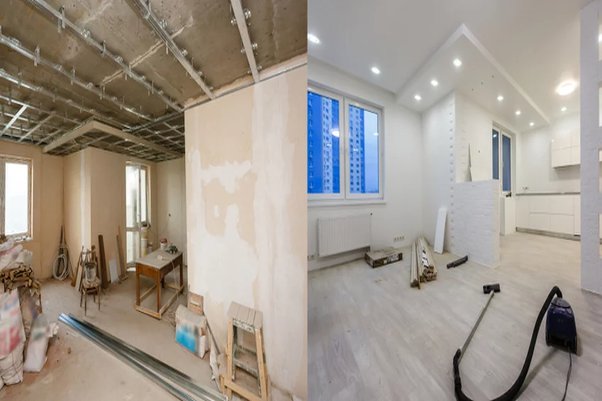Renovation and refurbishment are two words that are often used interchangeably, but in fact, there are distinct differences between them. While both processes involve making changes to a home or building, the scope of each project varies significantly. In this blog post, we will explore the key differences between renovation and refurbishment, so that you can decide which option is best for your home improvement project.
Definition of terms
Renovation is a process of updating and restoring an existing structure, often with a focus on improving the aesthetic or functional features of the space. The process typically involves modifying existing structures and surfaces such as walls, floors, fixtures, and cabinetry, as well as making other improvements like adding electrical wiring or replacing plumbing.
Refurbishment is a process of bringing something back to its original condition or better, often with the aim of restoring its functionality or improving its aesthetic appearance. This type of project usually involves repairing or replacing worn-out components, cleaning or refinishing surfaces, and replacing any damaged parts.
The process
It can also involve replacing systems like electrical and plumbing, and installing new fixtures such as cabinets and countertops. It requires a great deal of planning and can involve numerous tradespeople to complete the project.
Refurbishment is usually a less intrusive process and often involves freshening up existing features or minor structural changes. This could include repainting walls, replacing flooring, updating fixtures and fittings, and modernizing systems such as lighting and heating.
The cost
The cost of renovation and refurbishment varies depending on the scope of the project. Generally, renovations are more expensive than refurbishments due to the extensive work involved. For example, if you were to redo your kitchen, a renovation would involve replacing cabinets, counters, and appliances, while a refurbishment would likely focus on refinishing existing cabinets, replacing hardware, and updating lighting fixtures.
Refurbishments are generally more cost effective as they require less materials and labor to complete.
Refurbishments may also be more budget friendly because they often require less planning and design considerations than larger scale renovations. If you’re trying to stay within a certain budget, refurbishments are typically a better option.
However, depending on the condition of the space or building, renovations may be necessary to bring it up to code or repair any damage.
The Results
When it comes to the results of renovation and refurbishment, there is a major difference. Renovation is typically used to increase the value of a property and can often lead to more livable space. In most cases, the end result is a completely transformed area with improved functionality, an upgraded look, and a higher property value.
Refurbishment, on the other hand, is used to improve the overall condition of an area without changing its core design or layout. This can include painting, replacing carpets, and repairing any existing damage to create a more aesthetically pleasing space. The end goal of refurbishment is usually to restore the original appearance of the area without adding any new features or making drastic changes.
Key Differences between Renovation and Refurbishment
1. Purpose: The primary difference between renovation and refurbishment is the purpose behind each process.
2. Scale: Renovations are typically more extensive and complex than refurbishments. Renovations can involve a variety of different trades and professionals, while refurbishments typically focus on fixing specific problems.
3. Budget: Renovations are often more expensive than refurbishments, as they involve more extensive work and may require the involvement of more professionals. Refurbishments are typically more budget-friendly, as they focus on fixing specific problems.
4. Timing: Renovations can take longer to complete than refurbishments, as they are more extensive and complex.
5. Results: The results of a renovation are typically more significant and transformative than the results of a refurbishment. Renovations can change the look and feel of a property, while refurbishments typically improve its condition but don’t significantly alter its appearance.
Also Read: Quonset Hut Homes – Top 5 Design Ideas For A Tiny House
Conclusion
In conclusion, renovation and refurbishment are both processes that can help improve the functionality and appeal of a property. Understanding the key differences between the two can help you make an informed decision when it comes to improving your home or building. Whether you’re looking to renovate your home or refurbish a specific component, it’s important to work with experienced professionals who can guide you through the process and ensure that the end result meets your needs and expectations.

